This post was originally published on The Asian Age | Home.
-
As per the survey, new businesses received by Indian services firms increased for the seventeenth month in a row in December
-
India’s manufacturing sector activity continued to expand in December, with the S&P Global Purchasing Managers’ Index (PMI) rising to 57.8
This post was originally published on The Asian Age | Home.
-
Court documents reveal that pubs and pokies baron Bruce Mathieson’s Endeavour Group may have underpaid $700,000 in stamp duty when buying the Captain Cook Hotel in Sydney. Callum Foote reports.

This post was originally published on Michael West.
-
Qantas’ Sydney to London double decker jumbo QF1 flight has been forced to land in Baku after a fire reached the cockpit

This post was originally published on Michael West.
-
Wall Street calls for Musk to step down had been growing for weeks and even Tesla bulls have questioned his focus on Twitter
This post was originally published on The Asian Age | Home.
-
The post 10 Blak Businesses to support during the festive season appeared first on IndigenousX.
This post was originally published on IndigenousX.
-
Unions in New Caledonia have secured a 4.2 percent increase of the lowest salaries from January 1, 2023.
The concession by the employers’ organisation MEDEF was announced as a large crowd rallied for a general strike outside its offices in Noumea.
According to police, 1500 people had gathered to press their demands while the unions said they mobilised 5000 members.
The unions had sought an across-the-board pay increase of six percent in the private sector to offset the impact of inflation, which in November was 4.4 percent.
The wage hike applies to those earning between the monthly US$1440 minimum pay and those earning up to US$1775.
MEDEF said inflation has hit businesses hard as production costs are rising faster than product prices, in particular with the rise in the cost of energy.
Decline in GDP
The organisation said New Caledonian companies faced a decline as GDP had dropped by 5.9 percent since 2018.MEDEF said the social partners became aware early on of the negative impact of imported inflation on the purchasing power of New Caledonians.
It said that as early as May it and the unions unanimously and jointly asked the government to hold a conference on wages.
MEDEF said since April there had been proposals for tax reform which combined economic recovery and resetting of net wages.
It said raising wages had therefore always been a key aspect of the planned tax reform.
The government plans to hold a conference next week to discuss reforms in view of the crisis facing public finances.
This article is republished under a community partnership agreement with RNZ.
This post was originally published on Asia Pacific Report.
-
The government has also cut the rate on export of diesel to Rs 5 per litre from Rs 8 per litre
This post was originally published on The Asian Age | Home.
-
Australian Super have been locked out of their accounts for over three weeks now as the financial giant struggles with technical issues.

This post was originally published on Michael West.
-
Whistleblower Troy Stolz’s defamation trial against ClubsNSW will run into next year. He ended up in hospital in the wake of five days of cross-examination last week

This post was originally published on Michael West.
-
Let’s face it, it’s been a tough year. We were all hoping for a bit of respite from disease, famine and fire but 2022 has, in many ways, thrown us even greater challenges. So right now I need some optimism, something to celebrate.
And that something does exist. It’s a new program that makes me smile in gratitude because it’s a simple idea that seems to have made life better – for women, their families and their communities.
The Women’s School of Leadership has been rolled out in the Pacific – Timor-Leste and Papua New Guinea (PNG) – for the first time ever in 2022. It’s run by Fairtrade Australia New Zealand (ANZ), with a little help from our friends (like the Australian Department of Foreign Affairs in Australia and the NZ Ministry of Foreign Affairs).
Around twenty students from Fairtrade coffee farming cooperatives in both Timor-Leste and PNG took part in the program over the course of the year and graduated recently. Their subjects included topics as diverse as income diversification, sustainable farming practices and gender equality.
Amy Child, Gender and Child Protection Advisor for Fairtrade ANZ, said that the initiative is life-changing for everyone involved.
“It’s not just women who participate, although they are in the majority. The school is really about getting both men and women to understand the value of women in business, leadership, farming and across all parts of society,” says Amy.
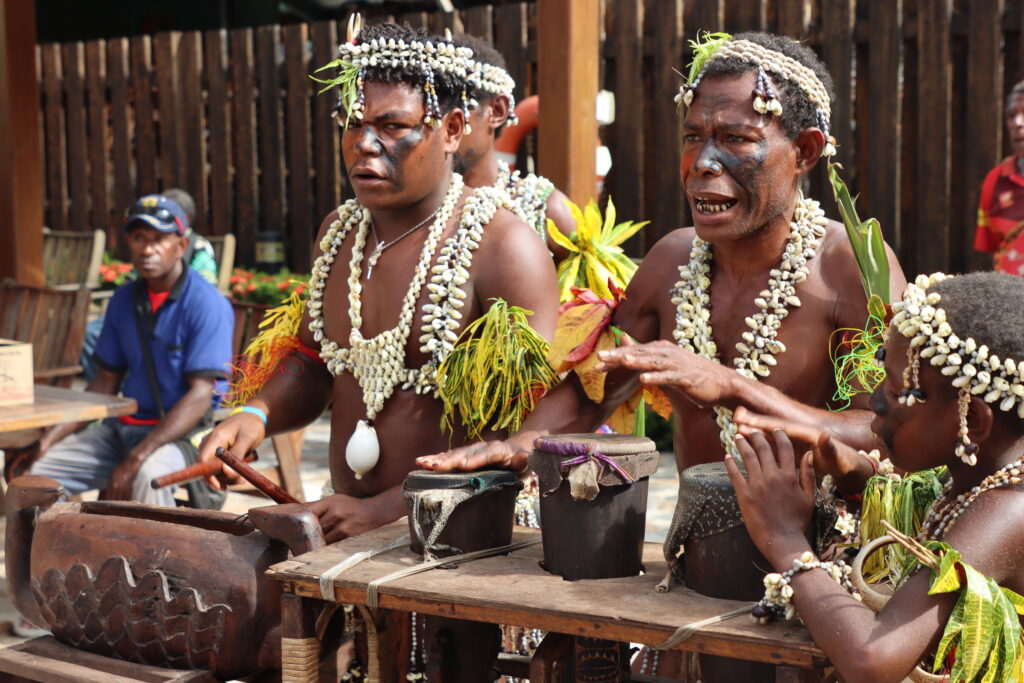
Traditional dancers from Unen Choit coffee farmer cooperative welcomed the graduates and special guests to the graduation ceremony for the Gender School of Leadership in PNG. Picture: Supplied
“The hope is that all the participants go on to become gender equality ambassadors and leaders in their own communities so that change happens from the ground up.”
The schools were well received in both countries with local dignitaries and government officials, including President Dr. Jose Ramos Horta in Timor-Leste, attending the graduation ceremonies. This was, in part, a result of the program being designed from the grassroots and utilising in-country expertise so that the lessons were relevant and culturally appropriate. For example, the PNG school had a name change. It became the Gender School of Leadership despite the program usually being referred to as the Women’s School of Leadership in other parts of the world.
“We felt that Gender School of Leadership made more sense in the PNG context after consultation with lots of different stakeholders. I am also proud to say that we drew upon local skills to deliver the curriculum so that it worked for PNG,” says Gabriel Iso, PNG Team Leader for Fairtrade ANZ.
“The coffee growers know that we understand not just the coffee business but also what the community needs. Our work is about fair pay for coffee but also assisting in areas like women’s rights, child protection and environmental sustainability.”
The program is delivered in modules and in PNG, the facilitators were thrilled to learn of the popularity of outreach work that participants were doing in local communities between classes. It was reported that in some remote villages more than 100 people travelled to listen to school participants speak about what they had learnt about how to change the gender paradigm.
PNG participant Veronica Akianang expressed it in this way: “In all rural communities, women and girls are often neglected, yet they are passive achievers… They plant the trees, they plant crops, they do care for land, rear animals, and work on the farm each day, yet, their voice is not being heard. They are left behind … and are unable to reach to their full potential.”
Her feelings are echoed in international research. A UN study showed that on average, women make up about 43 percent of the agricultural labour force in developing countries. Evidence indicates that if these women had the same access to productive resources as men, they could increase yields on their farms by 20 to 30 percent, raising total agricultural output in these countries by 2.5 to 4 percent.
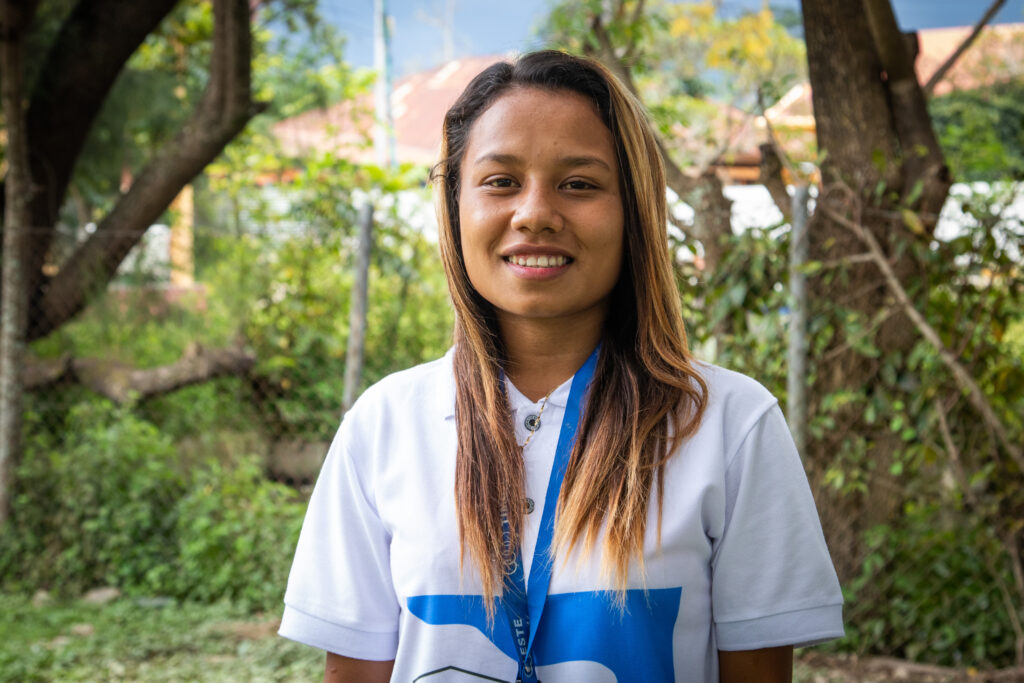
Madalena da Costa Soares, 23, graduate of the first Fairtrade Women’s School of Leadership in Timor-Leste. Picture: Supplied
Amy Child says the program aims to address this: “Recognising womens’ contributions is crucial for both the women themselves and their communities because when womens’ work is valued, it means their opinions and ideas are also valued. This enables them to become decision makers and leaders, which are all steps towards gender equality, especially in rural communities.”
Madalena da Costa Soares, a graduate from the Timor-Leste Women’s School of Leadership, spoke at her graduation ceremony in front of President Ramos Horte and was encouraged by him to think big: “I was very excited… it was my first time meeting him and speaking in front of him. And he said that he was so impressed that he would support me to become a member of Parliament.”
It seems 2022 did deliver something then.
- Picture at top: Some of the first cohort of students at the graduation ceremony for the Gender School of Leadership in PNG. Picture: Supplied
The post A new gender school of leadership in the Pacific appeared first on BroadAgenda.
This post was originally published on BroadAgenda.
-
Can you tell me a little bit about your role at your game design studio, Forever Stoked? It seems like it’s cooperative or non-hierarchical. How does that work in what you do?
I don’t like being a boss of people. I’m okay at it I guess, but I am a pretty radically-to-the-left person who’s continually lived a life where that is what’s important. I used to play in bands and tour full-time and did a label. I don’t necessarily have success averseness, but also I honestly don’t really care about money. I want to make sure I have enough to pay for the apartment and whatever. I’d been talking about wanting to do the studio as a co-op for years, and we finally made the jump. Basically everybody that’s worked for me is now a partner.
In terms of organizational structure, it’s largely flat. There’s a degree of different roles—we have design leads on various projects because we do systems design, we do graphic design, we do writing, we do content generation type stuff like writing trivia questions or adventures for games that have narrative stories, stuff like that with games, and then we do some stuff with comics. Within that creative space, functionally, we’ve decided that it’s very difficult to have it purely, entirely non-hierarchical in terms of the creative work side. So all the business stuff is flat. We basically vote on stuff. We try to figure things out. Creatively, there needs to be someone who’s the final authority on any given project.
If there’s a disagreement, we talk about. We want to make everybody happy. We try to reach consensus. But practically speaking, there are times where it’s like, “Yeah. Well, we’re split on this one.” What we do is we establish that early in the project; we have a clear tiebreaker that’s established before anyone knows if they’re going to disagree or exactly how they’re going to be involved in it and how their involvement’s going to develop over the life of making that project.
What was something that you wish someone had told you when you had first started doing this business and working in this industry?
One of the biggest things for me is be true to yourself and have a vision of what it is you want to be doing, and then do that. Don’t worry as much about fitting into the boxes that other people have created for how you can exist in the industry and the kind of stuff you can make and the way you do business. I think looking back, I wish I had embraced that earlier, but I was still the weirdo when I was first doing little bits and pieces of stuff. A lot of it comes from doing a DIY, punk and hardcore label and bands; that attitude and energy is something that I brought with me when it came to starting to make things.
Sacrifice is a big thing. I think I did it but I wasn’t as intentional about it early on in my career. I’m very in the mindset that we need to remove barriers to entry to help get more people involved, and we need to keep it from being a thing for people that have the money to do—they need to fuck off and not make money for a while. But, yeah, I am also a big believer there are sacrifices you can make to get to the place you’re in.
I don’t have kids. I’m not interested in kids and that means that that’s a whole full-time job that costs a ton of money that I don’t have to deal with. No judgment in any direction, but people are like, “Well, how did you do it?” And I’m like, “Well, I lived very DIY punk rock lifestyle and don’t have kids or expenses,” and so, sure, I was able to go volunteer for this company and chase after this thing and do that. I didn’t think about it as directly as that at the time.
Being more mindful about the choices I was making and the impact they were going to have and thinking a little bit further ahead, maybe that’s it. I wish I had told myself to think a little bit further ahead. Think about where you want to be, think about what your dream situation is in a more specific way, too, because I think it’s very easy. It’s important not to be unrealistic in the realities of what it takes to do the stuff.
You have to recognize that if you want to put time into this, you have to lose time somewhere else.
I feel like “I don’t have time” is largely not actually what the situation is. It’s that I’ve not prioritized this in my life. And there’s zero value judgment around how people should or shouldn’t prioritize things in their lives, but it’s like, “Yeah. Well, I don’t want to give up my day job, I really want to have a bunch of kids. I want to have this. I want to have that.”
Another big piece of advice: Don’t compare yourself to other people. I think everyone says this all the time. No matter how many times any of us hear it, it’s impossible to actually do, but we’re still all going to say it because really the best you can do is not compare yourself to other people because you don’t know their circumstances.
The flip side to that is you can make as much luck as you can. You can really up that. That’s why I do so many conventions a year and used to do even more. My biggest game on the road year, I did 236 days on the road, I just cranked out conventions and was going everywhere, talking to everyone. Even things that were one in a thousand chance, I gave myself a few thousand chances, so that volume of chasing those opportunities I think is really hard. It’s not going to find you, right?
Everybody can look at that one person who, “Oh, well, I don’t know. I just got plucked out of obscurity, fucking around and look at me now,” right? Yeah, sure there’s always outliers and exceptions to the rule, but really you got to put in the effort.
How did you manage to create a path for Forever Stoked outside of the established system of the tabletop gaming industry?
I’m 40 and our generation, a lot of parents in my mom and grandparents who raised me very much like, “You can do anything, you’re smart. You’re talented. Whatever you want to do, you can do it. I believe in you.” Then when I was a teenager and getting into punk, which I’m going to use as a giant umbrella, I was reading Henry Rollins’ Get in the Van. That sort of energy has run as a thread through what we do with Forever Stoked, where we say yes to kind of whatever, we chase stuff that we probably have no business chasing after as potential clients. Part of the joy of being able to have that kind of path is that we largely do what we want. We’re very values first as an organization, myself as a person, and we’re able to do that because we have carved this path.
We’re kind of the cool weirdos in the game industry. I’m not a cool weirdo in the wider world, and I’m not trying to insult the game industry either, but there’s not a whole lot of people covered in tattoos that are ridiculous cartoon characters that played in bands, just the profile that we cut is our branding is all. We look like a black light poster. Our aesthetic is this very out-there thing. There are enough people that are into what we do that when they find us or we find them, whatever, it’s like, “Oh, we totally vibe.”
How do you avoid burnout in your career?
When you have a good answer for that, I would love to hear it. As much as I want to say that I’m not the boss and that it’s not hierarchal, everyone still screens me that way, and it means that there’s a lot of extra pressure on me. But I’d say honestly for me, a lot of it is just keep going. The just keep swimming philosophy of, “I can’t be burned out so I’m not,” or I try not to be. But that said, I’m trying to be better.
Something that I get to do because the studio has been growing is that I do have the ability to shift my focus day-to-day. If I’m feeling like my brain’s just not interested in being creative right now, that’s not going to happen. There’s plenty of other shit I can work on. There’s a diversity of things that I can do that are still furthering the work that we’re doing and the cool stuff we’re making, but that doesn’t require me to be as on. I can look at a calendar and try to figure out who we want to meet with at a convention. Stuff like that is a lot less demanding and taxing mentally, so I can sort of half work. I mean, now I sound like a psycho who just works all the time. But I mean, the thing is that I legitimately adore what we do.
I think there’s a doggedness that comes from that DIY culture where you’re like, “I’m always trying to find a path to that success,” and the success is whatever you define it to be, right?
Yeah. That’s something that’s really stuck with me for the co-op: I would rather have a dope life than a bunch of money. I’m fortunate enough that at this point in my life, we do okay. Well, we do more than okay. I mean, we do great. If you’re a business bro, we don’t do great. But for my standards, we do great.
I’m also very not interested in any of that materialistic consumption type stuff. I wear jeans until they fall apart, which I think comes from the punk rock, but also just years and years of not having stuff. Growing up, we went through periods of time where we didn’t have money, certainly not to a degree that a lot of people have had to struggle through. We weren’t worried about ever being homeless, but we had to move with my grandparents. So thinking about what you spend money on, and what it actually makes you happy, which also comes from punk rock where it’s just that kind of anti-materialism.
I am very proud of the fact I live my values in the sense that I try as much as possible to make as little money as possible when it means that I can help other people do cool stuff, and we can build something together. That’s been the attitude before we were officially a cooperative for a long time, and now I’m excited about really putting our money where our mouth is, to go somewhat esoteric. It’s one of the core tenets of Leninism that set it apart from some of the other competing lead interests in building the USSR before Stalin turned it into absolutely fucking garbage.
I think a lot about business structure and co-ops and how we can do things in the world at large. This idea that if we had good people who made a thing and then were great and now we’re giving it to the people. When the labor movement really took off, it seems like most of the most successful things in business followed that sort of pattern where it was a more traditional business, or it fell within that kind of like, “Yeah, there’s a boss, there’s an owner, there’s a couple owners,” or whatever it is. Then at some point it was decided, “Hey, we have this successful company, now let’s convert it to a co-op, make it work. Let’s do that.”
I’ve been involved in a lot of political work over the years and various other sort of co-op type things, both creative and otherwise, and it’s difficult to get you going when you have a bunch of opinionated weirdos that are like, “Well, I don’t know, I read this book and that book,” and then all of a sudden you’re debating Trotsky. It’s good and interesting, but also difficult to get over that hump to make a sustainable business from the ground up. I want to say that that’s what more people should do.
I want to say that that’s where society should be, and I think that that is where I would like society to get to. This business is a real-ass business and everyone makes salaries the same that you would make if you were doing this, in, say, a more corporate world. That money’s there. Business is making that kind of money. It’s just now we’re distributing it more equally amongst everybody, and having that money makes it so much easier to then redistribute. It’s difficult to redistribute wealth when there isn’t any wealth.
Matt Fantastic Recommends:
Watch Everything Everywhere All at Once
Be more like Ted Lasso and Roy Kent
Listen to new music
Read Emma Goldman’s autobiography, Living My Life
Give up the whole idea of “guilty pleasures” and take unabashed joy in the things you like
This post was originally published on The Creative Independent.
-
Qantas is pulling back capacity to keep airfares high as cagey chief Alan Joyce seats customers and staff in Economy, upgrades shareholders to Business Class. Michael Sainsbury reports on the insipid ACCC report into airline competition.

This post was originally published on Michael West.
-
New York:
Small business in New York who are suffering from financial crisis and want to start a new business need not worry anymore.
New York City is ready to provide them grants to overcome the financial crisis and loans on easy terms for new businesses. Representatives held an awareness camp in Coney Island, Brooklyn, and provided information to the community before Friday sermons at the Makki Mosque.
 Business Outreach Specialist Mahedi Hasan informed that the city government will also provide licenses and legal support for businesses along with grants and loans.
Business Outreach Specialist Mahedi Hasan informed that the city government will also provide licenses and legal support for businesses along with grants and loans.In this one-day awareness campaign, Muslim Liaison Officer Atiya Shahnaz from the Mayor’s Office of New York City also received support.
The city government says that small business owners and new small traders can also get more information about this by contacting their website nyc.gov/sbs and their given number 888-727-4692.
The post NYC ready to provide financial and legal assistance to small businessmen. first appeared on VOSA.
This post was originally published on VOSA.
-
Like the players, brands have in the end shied away from confrontation with the hosts during the World Cup
More than £100m will be spent by brands hoping to cash-in on World Cup fever, but when it comes to taking host Qatar to task over its human rights record protest marketing has taken a back seat to sales targets.
In the run-up to kick off of the football tournament in Qatar criticism of the gulf state was akin to shooting at an open goal.
Continue reading…This post was originally published on Human rights | The Guardian.
-
The court was gripped by high drama in Troy Stolz’s case against ClubsNSW today as the Australian Government Solicitor contacted parties over pokies lobby claims the whistleblower breached confidence in contacting Senator Andrew Wilkie’s office. Callum Foote and Michael West report.

This post was originally published on Michael West.
-
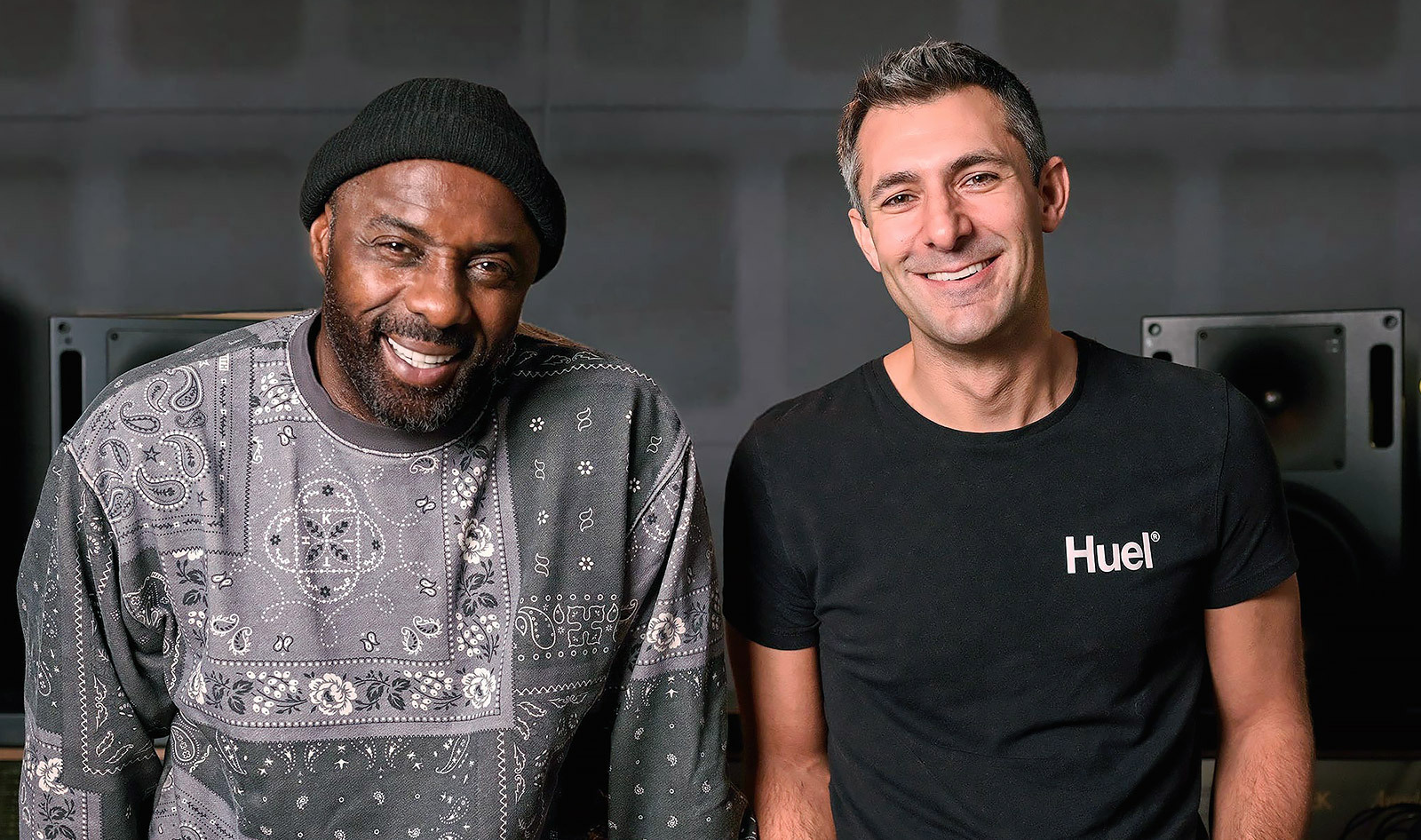
European vegan nutritional shake brand Huel recently raised $24 million in a Series B funding round, bringing the eight-year-old startup’s value up to $560 million. English actor Idris Elba—best known for his roles in The Wire, Luther, and Mandela: Long Walk to Freedom—and his wife Sabrina invested in the company alongside British comedian and TV presenter Jonathan Ross and activewear brand TALA’s CEO Grace Beverley.
“I’ve been a ‘Hueligan’ (a Huel fan) for several years now, starting my journey while preparing for my role in Thor, so to come on board with Huel was an easy decision,” Elba said in a statement. “I believe in their mission to deliver nutritionally complete food, sustainably. We have some exciting projects coming up and I look forward to spreading the message and raising awareness around healthy, low carbon food.”
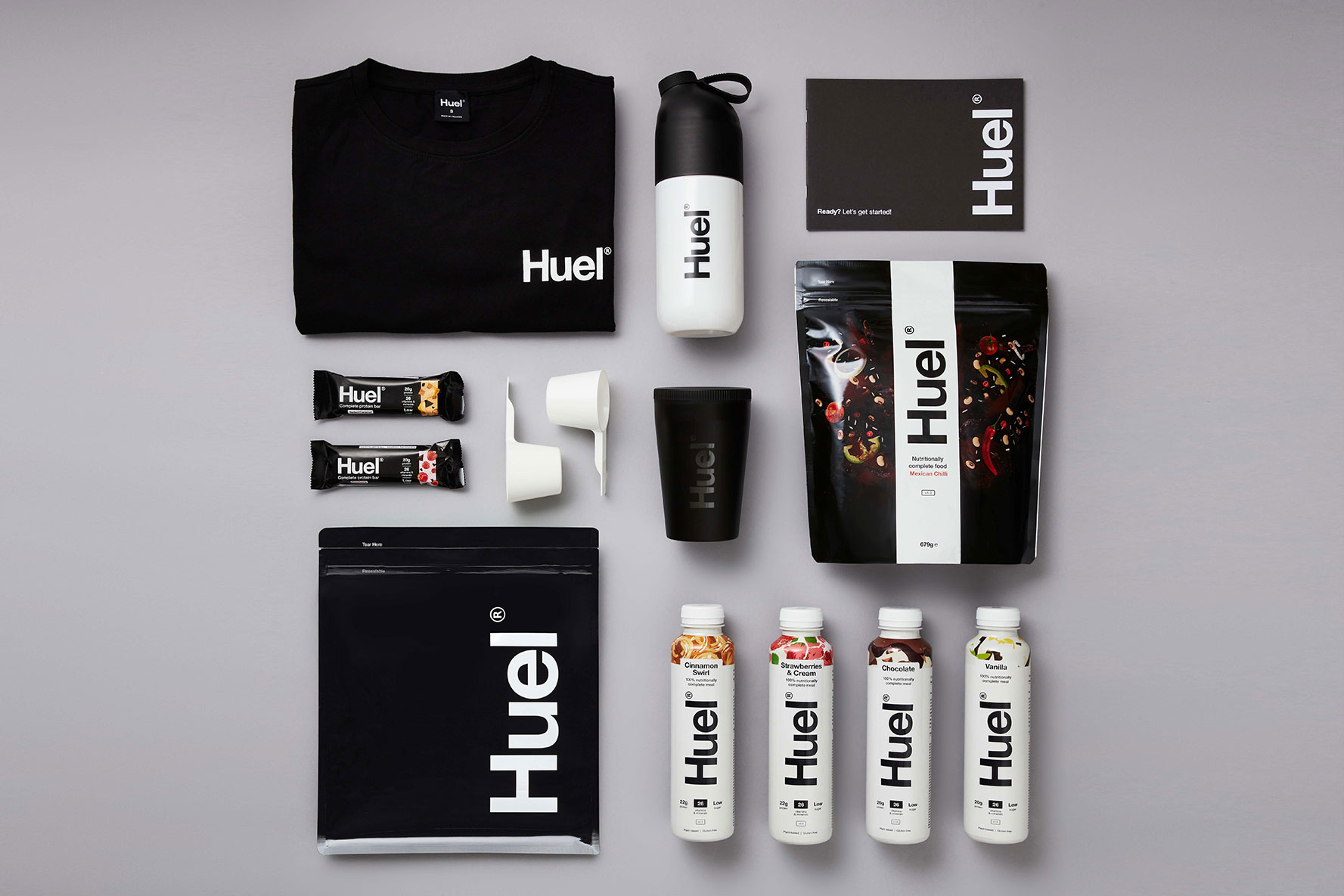
Huel
Huel—a portmanteau of “human” and “fuel”—was founded by Julian Hearn and James Collier to provide a solution to the environmental consequences of standard food production and food waste by making a nutritionally complete, convenient, affordable food solution with minimal impact on the environment and animals.
Its first product, a low-carbon-footprint protein powder, launched in the United Kingdom in 2017 and the brand has since expanded into ready-to-drink, snack bar, and hot lunch options.
“We are trying to change the way the world thinks about food and Huel offers a solution to help people make easy changes to their food choices,” Huel CEO James McMaster said in a statement.
Low-carbon vegan shakes
In 2019, Huel launched its nutritional bars in the United States following a $20-million venture capital round. And today, much of the company’s loyal fans—whom they call “Hueligans”—are in the US, representing Huel’s second-biggest market, followed by Germany and Japan.
Its strong growth—40 percent year over year—is attributed to the new product launches and the company’s expansion from solely direct-to-consumer to retail stores. The new funding will be used in continued international expansion with a focus on the US, along with new product innovation, and continued expansion online and in retail stores.
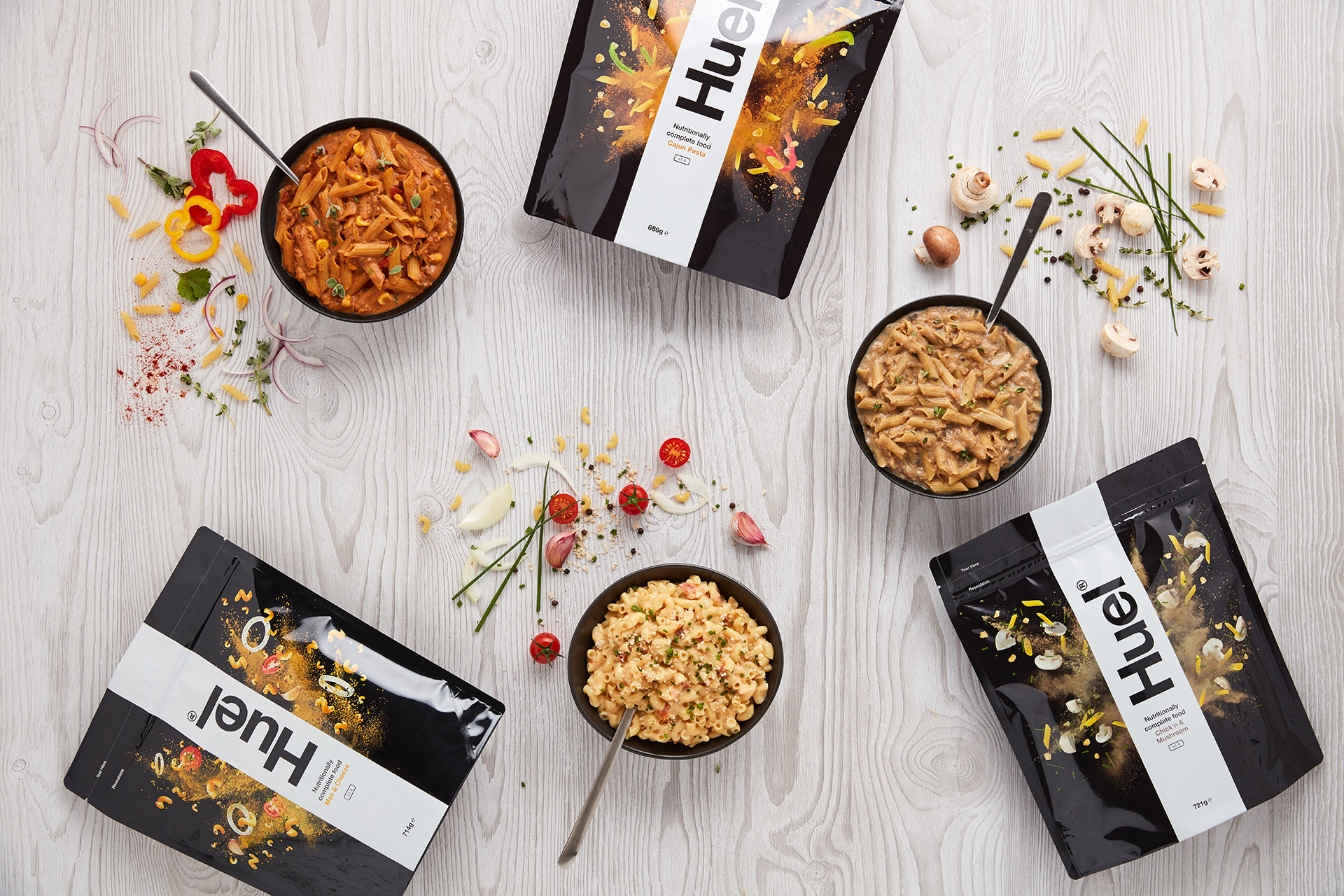
Huel
As part of the Elbas’s investment, one of the new projects will include Huel working with them on their climate change initiative to help people eat at 1.5°C, the global warming limit the Paris Agreement is trying to reach. Huel meals fit within a diet aligned with supporting that reduction, and Huel believes that raising awareness of our diets is one of the simplest and most effective actions people can take to tackle climate change.
“We’re excited to have the opportunity to work with Idris and Sabrina to raise awareness of the role of food in climate change and to encourage individuals and the industry in general to move towards a food system based on sustainable nutrition,” McMaster said.
Huel will work with the Elbas to inspire and motivate people about the benefits of changing diets to support the health of the environment, which is a vital component of food sustainability.
Plant-based diet helps fight climate change
Many experts would agree that the diet that best aligns with the goals of the international treaty on climate change is one that excludes animal products. According to the United Nations Intergovernmental Panel on Climate Change (IPCC) report published last year, human activity—including the ways we grow or raise our food—is “unequivocally” responsible for climate change and humanity has only a few years left to keep the planet from warming 1.5°C past post-industrial levels.
And while fossil fuels are often seen as having the most negative impact on the climate crisis, animal agriculture—which contributes to one-fourth of total greenhouse gas emissions—is mostly ignored. Approximately 30 percent of the world’s ice-less land mass is used for animal agriculture and 33 percent of all cropland is used to grow food for those animals.
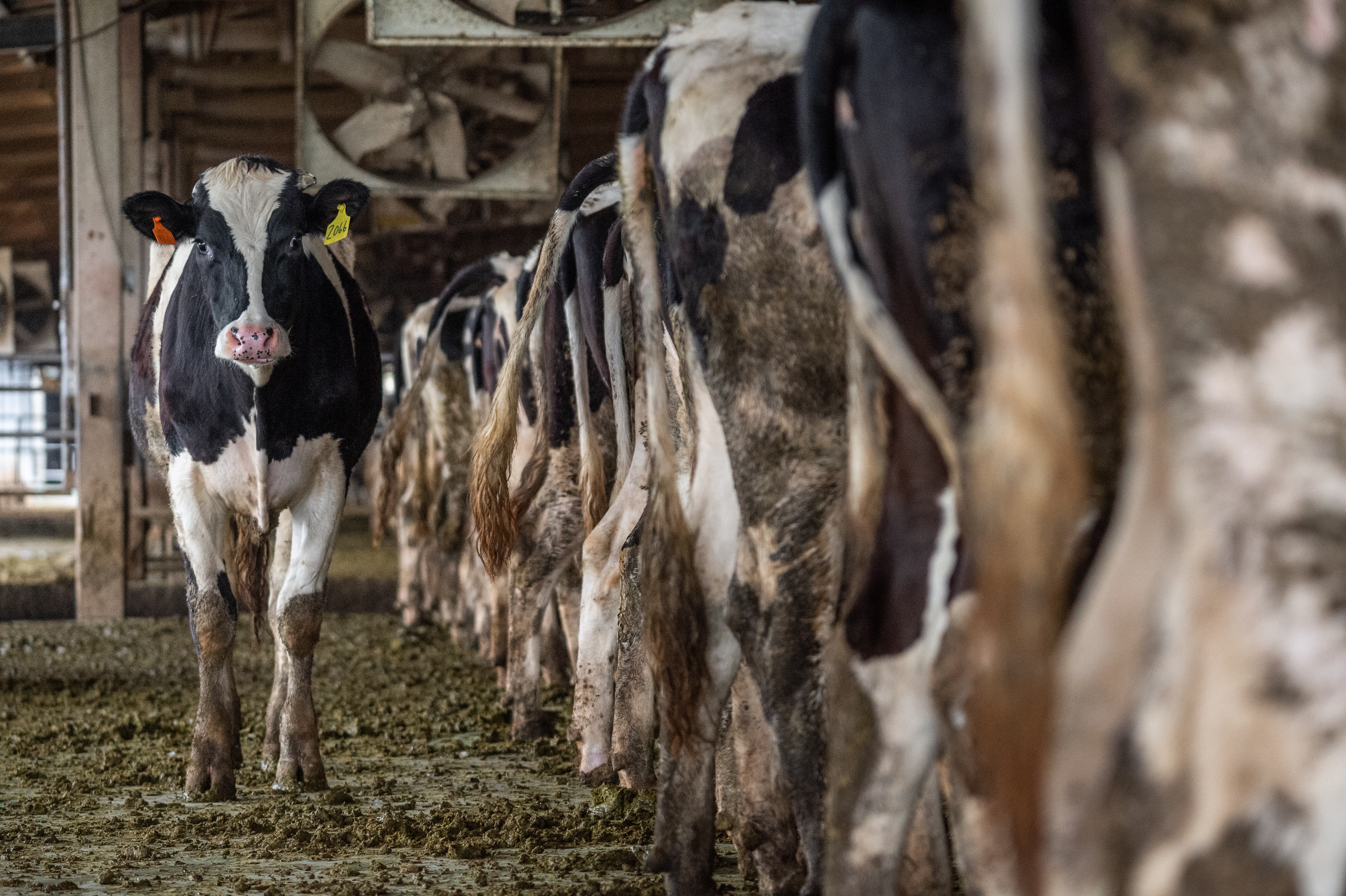
One of the most comprehensive studies pointing to the environmental impact of animal agriculture was published in 2018 by Oxford University researchers, who spent five years compiling data from nearly 40,000 farms in 119 countries and examining the environmental impact of producing 40 foods—which amount to 90 percent of all food eaten on earth.
The researchers found that the global meat and dairy industries are responsible for 60 percent of greenhouse gas emissions and that if individuals removed animal products from their diets, they would reduce their carbon footprint by 73 percent. The researchers also found that if meat and dairy production were to cease, global farmland use would be reduced by 75 percent.
“A vegan diet is probably the single biggest way to reduce your impact on planet Earth, not just greenhouse gasses, but global acidification, eutrophication, land use, and water use,” study lead author Joseph Poore said in a statement.
Another report published earlier this month by the Institute for Agriculture and Trade Policy and the Changing Markets Foundation found that the methane emissions of five of the largest meat corporations and 10 of the largest dairy corporations is equal to more than 80 percent of the European Union’s entire methane footprint.
The report also estimated that the combined methane emissions of these 15 companies—which include JBS, Tyson, and the Dairy Farmers of America—exceed the methane footprint of entire countries including Russia, Canada, Australia, and Germany.
“To tackle these emissions in a substantive manner, the number of animals in mass industrial systems of production must be dramatically reduced,” the report says. “This is the most effective measure to reduce emissions from animals themselves and emissions from their manure.”
This post was originally published on VegNews.com.
-
This is the fifth consecutive rate hike after a 40 basis points increase in May and 50 basis points hike each in June, August and September
This post was originally published on The Asian Age | Home.
-
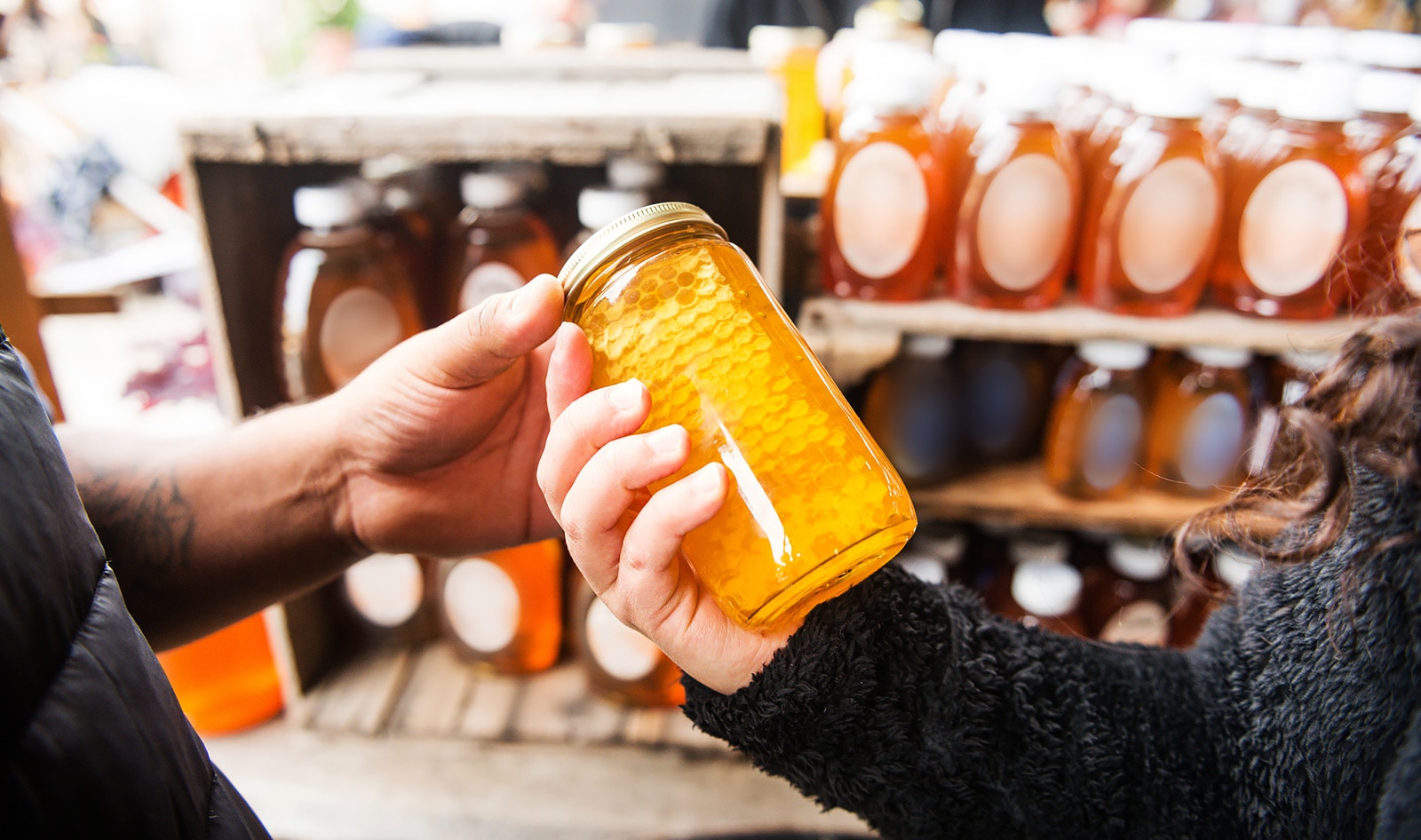
European consumers will soon be able to indulge in real honey without exploiting a single bee. That’s because MeliBio, the California-based startup that unveiled the world’s first real honey made without the use of bees, recently announced a partnership with Narayan Foods, Europe’s largest organic and sustainable plant-based food producer.
Through the partnership, MeliBio will become available across 75,000 European stores under Narayan Foods’ Better Foodie brand.
“As a food innovation platform, Narayan Foods is constantly on the lookout for novel sustainable products that would revolutionize the market,” Mario Brumat, founder and CEO of Narayan Foods, says in a statement. “Just by tasting MeliBio’s incredible plant-based honey, we knew we had discovered an innovation that would leave a distinct mark in the industry. We’re thrilled to bring the world’s first plant-based honey to every European household and establish it as the new favorite sweetener.”
 MeliBio
MeliBioEuropean consumers can expect to find MeliBio’s vegan honey in stores next year, with rollout expected to begin as early as the first quarter.
This news comes just as the startup adds an additional $2.2 million in investments from new and existing investors. Among new investors is The Greenbaum Foundation led by Jim Greenbaum, executive producer of hit vegan documentaries The Game Changers and Seaspiracy.
MeliBio makes real honey without bees
Founded in 2020, MeliBio utilizes patented technology and microbial fermentation to create real honey from plants and natural ingredients, therefore taking bees out of the equation.
The end product, Honey Without Bees, doesn’t just have the same look and taste as honey, it also boasts the same health benefits and is an easy one-for-one swap in culinary applications.
By taking bees out of commercial honey production, MeliBio is paving the way toward a kinder, plant-based food system that doesn’t rely on animal exploitation.
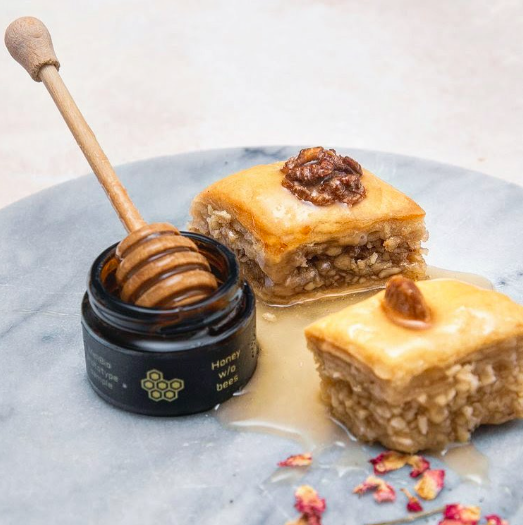 MeliBio
MeliBioIn traditional commercial honey production, bees are exploited for their ability to pollinate and ultimately suffer a host of health complications.
In nature, bees create honey by collecting nectar from flowering plants. After flying from plant to plant to collect nectar, bees fly back to their hives where they regurgitate the sugary substance, reduce its water content, and thus create honey. This honey is ultimately a source of nutrition for bees and is the insects’ primary source of carbohydrates.
In commercial honey production, however, bees are deprived of the honey they work so hard to create. Instead of collecting nectar from a variety of flowering plants, bees are transported to areas where they are only able to consume mono-nutrients from a single crop. They’re exposed to pesticides, no longer hibernate, and instead of relying on honey for nutrients, they are fed sugar water—a nutrient-less substance.
Aside from exposure to pesticides, bees also suffer from wing disease due to selective breeding.
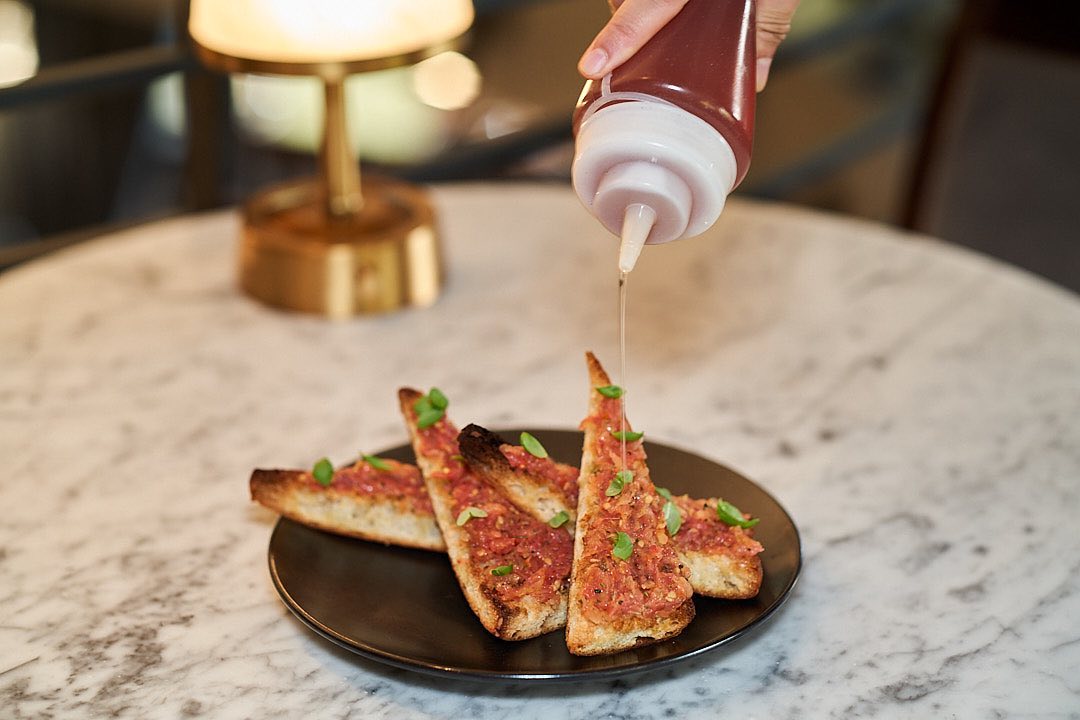 BAIA
BAIAMeliBio co-founder and CEO Darko Mandich—who previously worked in the Serbian bee industry—is familiar with the consequences of commercial honey production and is now working to change the industry altogether.
“I am not proud of things I did to the bees in my former roles, but I am happy that as an industry insider I know how to change this outdated industry,” Mandich previously told VegNews.
MeliBio’s upcoming European launch is only the latest step in the CEO’s mission to transform the industry.
“It is with great excitement that I bring our innovative MeliBio plant-based honey to Europe. We are proud to partner with Narayan Foods, one of Europe’s most respected sustainable foods producers, to bring our delicious and sustainable products to Europeans everywhere,” Mandich says in a statement.”
Honey without bees will change the world
Despite launching just two years ago, MeliBio is already making significant strides and collecting awards along the way.
Just last year, Honey Without Bees earned a special mention in TIME’s prestigious list of 100 Best Inventions of 2021. And this year, the bee-free honey was named to the SIAL Innovation Selection 2022, a prestigious food innovation award in Europe.
 Brad Weaver/Unsplash
Brad Weaver/UnsplashBeyond awards, MeliBio is helping wild bee populations thrive by ultimately reducing human reliance on honeybees.
Honeybees, which have been domesticated for commercial honey production, are incredibly adaptive and are able to collect nectar from a multitude of blooming plants. Wild bees, however, are known to collect pollen from very narrow sets of plants. When honeybees and wild bees compete for pollen, the latter suffer, and as a result, so do the plants and vegetation that rely on these wild populations.
With an abundance of healthy, varied species of bees, ecosystems are able to thrive. By reducing human reliance on honeybees, MeliBio is paving the way toward healthier, more abundant bee populations and thriving ecosystems.
This post was originally published on VegNews.com.
-
Rights groups say amended criminal code underscores shift towards fundamentalism
Indonesia’s parliament has overhauled the country’s criminal code to outlaw sex outside marriage and curtail free speech, in a dramatic setback to freedoms in the world’s third-largest democracy.
Passed with support from all political parties, the draconian legislation has shocked not only rights activists but also the country’s booming tourism sector, which relies on a stream of visitors to its tropical islands.
Continue reading…This post was originally published on Human rights | The Guardian.
-
Money-laundering whistleblower Troy Stolz is in court this week against pokies lobby group ClubsNSW. Whistleblowers David McBride and Jeff Morris were there to support him.

This post was originally published on Michael West.
-
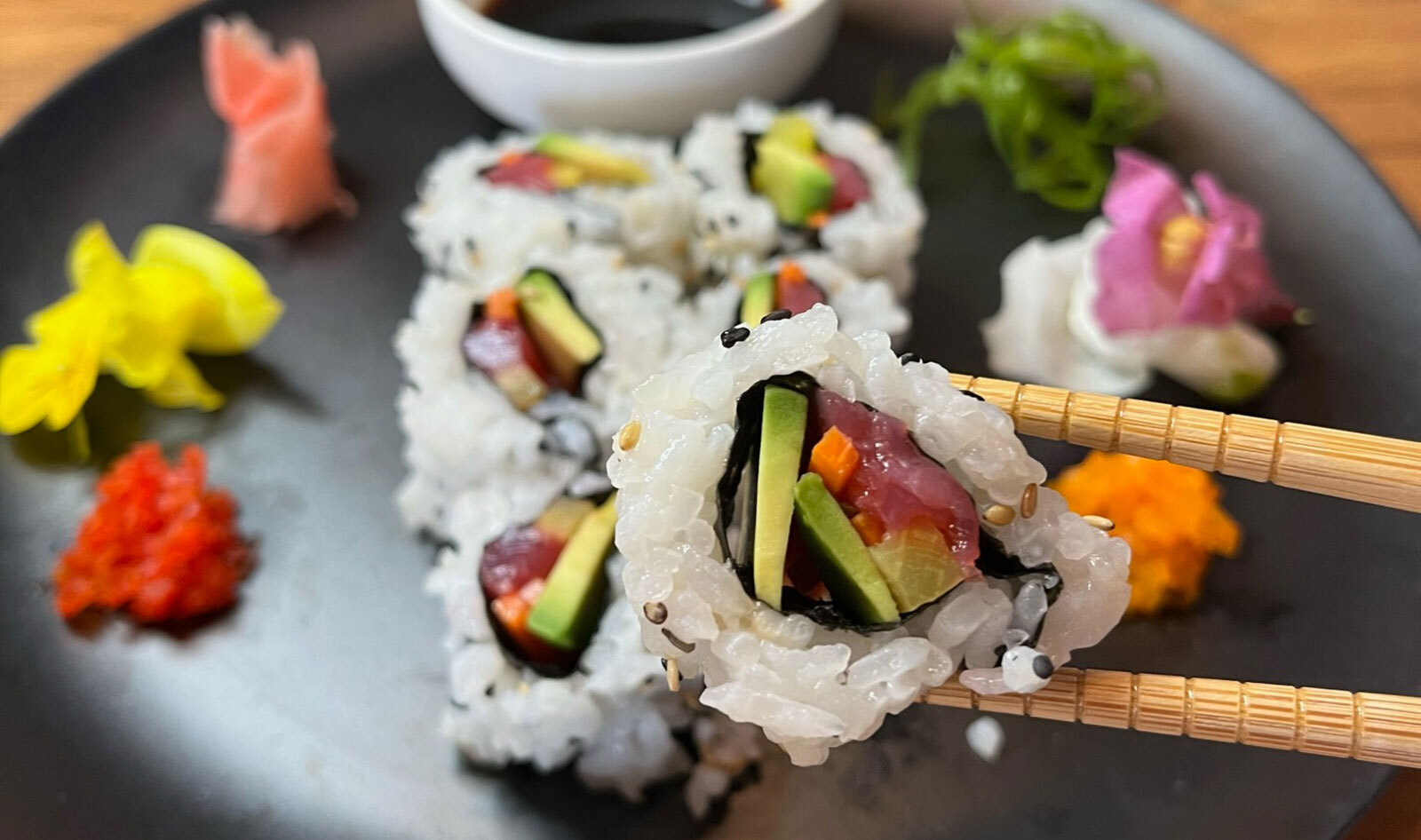
Vegan food has been evolving at a rapid pace and each new innovation seems to be better than the last. First came “bleeding” burgers, followed by realistic plant-based chicken. And now, seafood alternatives are coming into focus with startups proving that there’s more than one way to make realistic vegan fish.
There’s already vegan tuna and salmon made from protein-rich legumes, while others are made from soy or a root vegetable called konjac to mimic the taste, texture, and nutrition of fish. Most recently, several startups have begun harnessing the biological kingdom of mushrooms to innovate plant-based seafood even further.

Aqua Cultured Foods
Mycelium, the root systems of mushrooms, naturally grows in a structure similar to the muscle tissue of seafood and is soft in flavor. This unique structure has proven its ability to be used in diverse applications and has already been used to make mushroom leather and mushroom meat.
Soon, consumers will get a taste of the power of mycelium as a seafood alternative.
Creating fish-free shrimp and scallops
Chicago-based startup Aqua Cultured Foods is developing calamari, shrimp, scallops, and filets of tuna and whitefish with proprietary mycelium fermentation processes that do not use any animal inputs, genetic altering, or modification. The startup says that using mycelium allows it to retain naturally occurring fiber, protein, and other micronutrients.
Aqua recently raised $5.5 million in seed funding to bring its ultra-realistic seafood alternatives to market. It will use the investment to equip its new facility, scale up production, add key talent, and expand its roster of restaurant and foodservice outlets for product introductions this year.
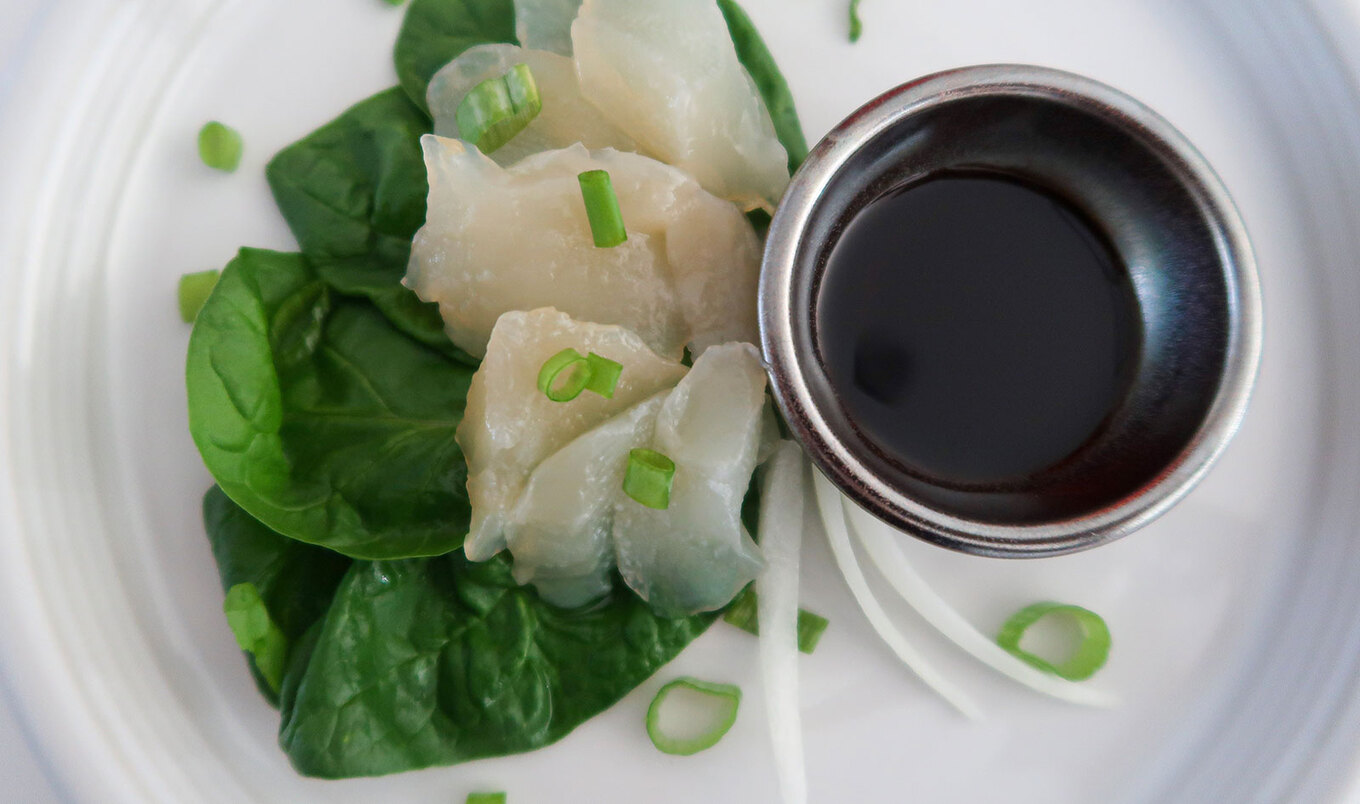 Aqua Cultured Foods
Aqua Cultured Foods“We appreciate having mission-aligned partners that offer strong strategic value for the next phase of our growth, which will involve building up the business and brand,” Anne Palermo, CEO of Aqua, said in a statement.
“Being good stewards of investor capital is important to us, so along with hitting milestones earlier than expected, we are benefiting from government programs, academic resources, and other advantages to get to market quickly.”
Aqua’s primary value is its low cost of scaling and its path to price parity, thanks to proprietary fermentation methods that use relatively affordable inputs and equipment. The startup recently acquired a food-grade facility that was already built out nearly to its requirements, which it estimates will save more than $1 million in construction costs.
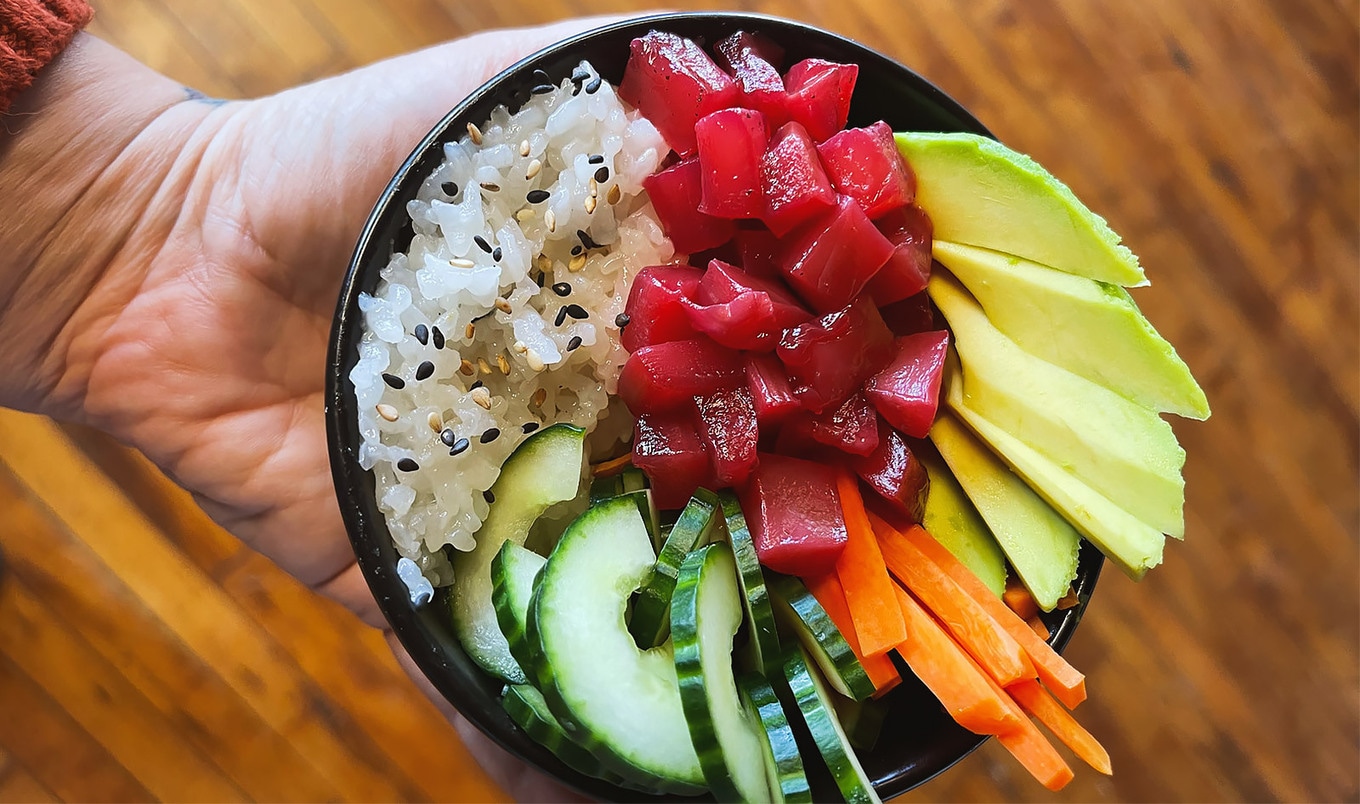 Aqua Cultured Foods
Aqua Cultured FoodsAqua also produces ground vegan seafood fillings for applications such as dumplings, ravioli, and sushi rolls. One of the startup’s options is a bulk shrimp alternative that can be seasoned, packaged, and co-branded by retailers or distributors.
Aqua Cultured believes this sector presents another lucrative and highly accessible market opportunity because frozen dumplings are a staple in countries such as China, South Korea, and Japan.
Vegan seafood aims to save the oceans
While Aqua is well on its way to bringing its products to market, other startups around the world are also harnessing the power of mycelium for vegan seafood. The first startup in Europe to make vegan seafood from mycelium is Germany’s Esencia Foods. Founded by scientist and chef Bruno Scocozza and business strategist Hendrik Kaye, Esencia has the goal of promoting a global transition to sustainable ocean stewardship with mycelium alternatives.
According to the United Nations, 80 percent of the world’s fish stocks are overfished, and with a projected increase in demand for seafood, some scientists are predicting that the oceans will be depleted by 2048.
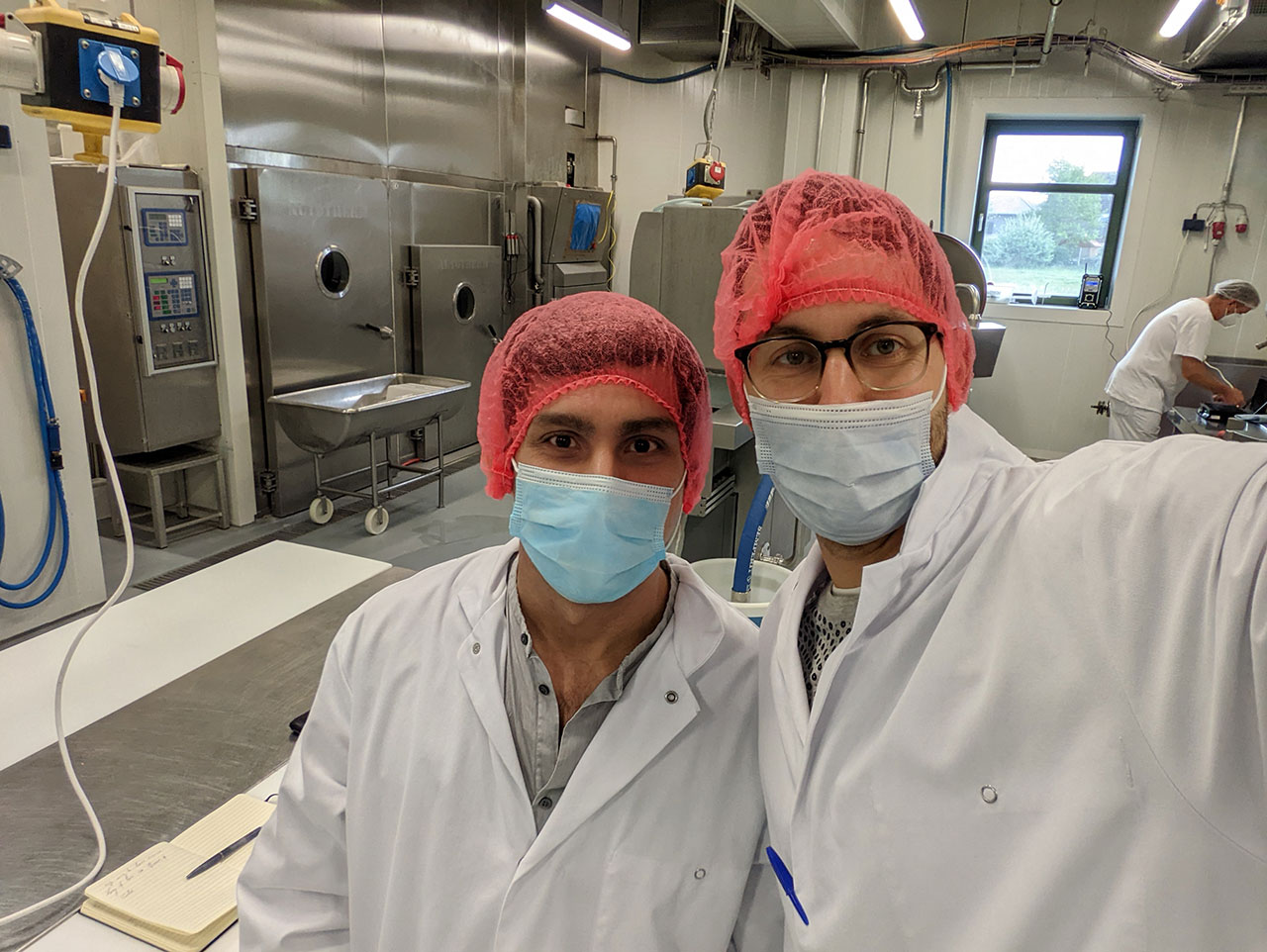 Esencia Foods
Esencia FoodsIn an effort to avoid the dramatic consequences of the ocean’s future, Esencia is developing a technology platform using mycelium that is capable of replicating seafood’s unique texture and mouthfeel to offer alternatives that better mimic conventional seafood, starting with scallops and salmon.
By leveraging a solid-state fermentation process, Esencia grows mycelium in a way that is similar to tempeh but using fungi that provides the soft texture for products such as scallops and the complex texture of fish like sea bass.
The startup also recognizes its challenges, such as recreating the fatty texture of smoked salmon. To get it right, Esencia plans to partner with a plant-based fat company. The startup hopes to launch its first products in restaurants and foodservice by the end of this year before expanding into retail.
“As a scientist-chef hybrid, I want to go beyond creating an ‘alternative product,’ but to build products that consumers crave because they are culinary highlights,” Scocozza said in a statement. “We want to write a chapter in the history of food.”
“Mycelium solid state fermentation is the perfect technology to build textures and tastes consumers love, while producing at price parity—to make a real impact,” he said.
Vegan seafood for fine dining
Similarly, another mycelium seafood project is underway in Copenhagen, where scientists are working with chefs at Copenhagen’s two Michelin-starred restaurant Alchemist to create a new seafood by growing fungi on seaweed. Funded by The Good Food Institute, the project’s goal is to demonstrate an innovative method of making sustainable foods through fermentation.
Headed by Dr. Leonie Jahn from the Technical University of Denmark and Diego Prado, the project will see the chefs experiment with fungi to eventually create whole-cut seafood. If successful, the product may be sold at the restaurant and could go on to be widely available for purchase.
“Our main goal with the project is to attempt to create a unique and delicious product that is good enough to be served at a fine-dining restaurant using natural ingredients, with seaweed providing flavors of the sea and the mycelium adding to an attractive texture,” Prado, who is also head of research at Alchemist, said in a statement.
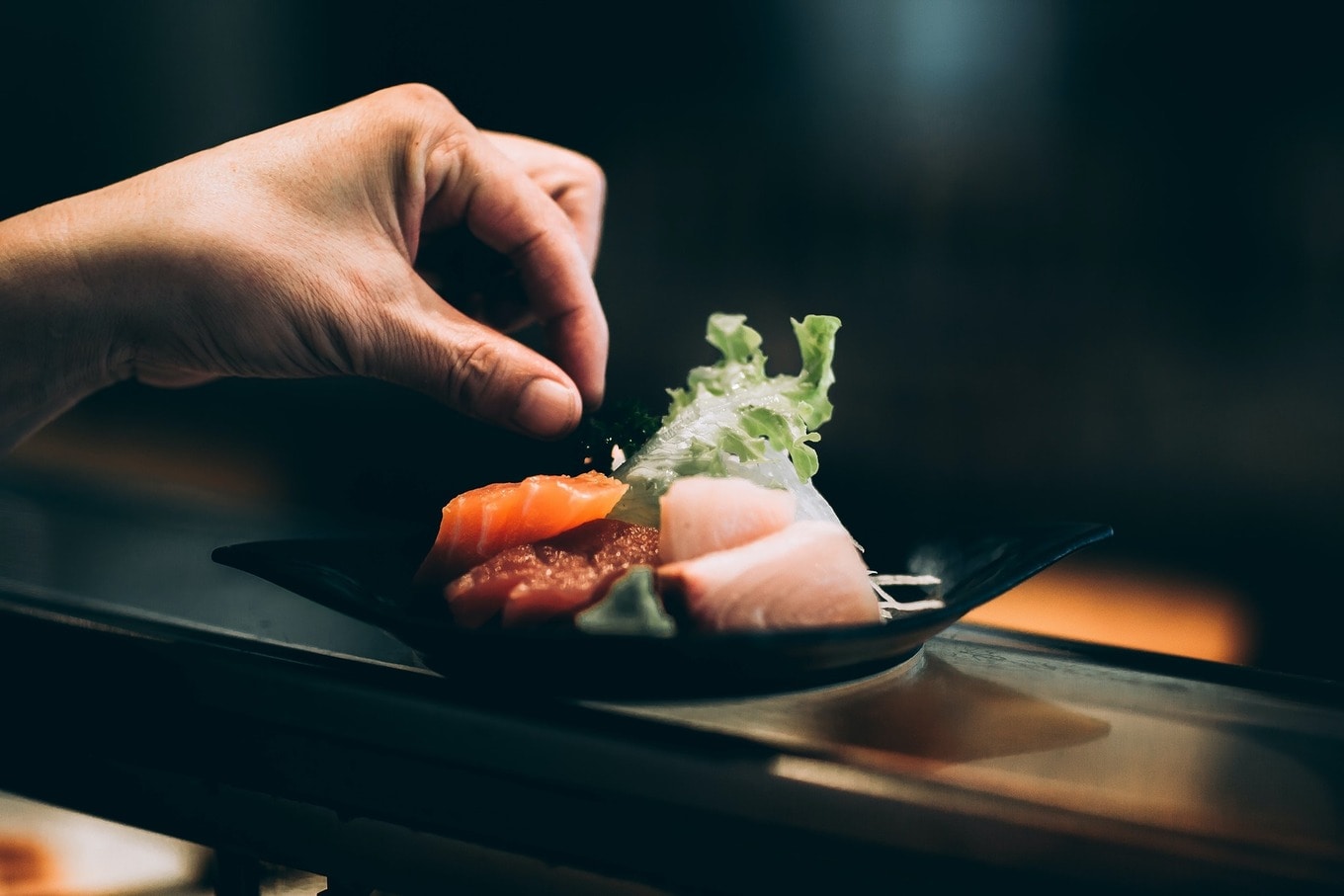 Aqua Cultured Foods
Aqua Cultured FoodsThe team is looking into how the texture of the filamentous fungi can be used to create a range of sustainable foods. The aim is to identify how different conditions can be used to alter the fungi’s texture, creating products ranging from scaffolds—which give structure to meat cultivated from animal cells—to animal-free foods that look and taste like meat.
“I will be fascinated to see the outcome of Dr. Jahn’s research,” Seren Kell, science and technology manager at the Good Food Institute Europe, said in a statement. “Seafood is an area where we urgently need to see innovation, and there are huge opportunities for companies and governments to invest in further research to develop plant-based and cultivated seafood that can help meet growing demand in a sustainable way.”
This post was originally published on VegNews.com.
-
Josh Frydenberg’s “world-first” Media Code is a world-first joke lapped up by a sycophantic media enjoying secret cash payments from Google and Facebook. Michael West reports on the hype and a shameless Treasury review.

This post was originally published on Michael West.
-
I would love to know how you describe yourself, where you’re from, what you do, how you define your work.
I’m from Brooklyn, born and raised, and I grew up on the south side of Park Slope. Both my parents were artists, hippies that knew how to save some money. I was fortunate enough to go through art school basically my whole life. I was immersed in the arts from a young age and I tried everything. I did singing, dancing, all that stuff. I played sax for a while, but I really fell in love with skateboarding, right when skate videos were becoming a cinematic experience. That was the fusion of my artistic upbringing, paired with my love for skateboarding and my fascination with video and music and rhythm, and all of the way those things work together.
I went to LaGuardia High School, and I was an actor there, so I had this whole company of actors at my disposal, and we were all acting, and working together. When I got into film, I basically started making films with those actors, which was incredibly exciting, and we were just way beyond our years at the time and I don’t mean in terms of our skill, but in terms of our ambition and gusto. Man, we were telling big, heavy, very dramatic stories, and we were just 16, 17 year old artists.
I went to SUNY Purchase for a second, but I left after a semester. School is great for a lot of people, but I felt like I was relearning a lot of things, and I was really curious to get my hands dirty. I wanted to be on the front lines of what was coming. The rise of the digital camera, DSLRs, Pocket Cinema, and all that stuff. I was like, “I want to be right there, ready to go, and learn all of this.”
I started Crooked Letter when I was 19 with a business partner. We do so many different kinds of work, big and small, but the main priority for me is—no matter what story we’re telling—finding the soul of the narrative and the subject.We do a lot of documentary work, so talent is the most important aspect of a project. If the person in front of the camera is not feeling their truest self, then we’ve failed.
Was there a specific artwork–be it a movie, or a skater, or an album—that you encountered, and felt really infatuated with? What was the gap like between being inspired, and making your own work, finding your artistic voice?
There was a video that came out Yeah Right!, and it was a really popular one that Spike Jonze was involved in. When I saw that, that blew my head apart. I was completely blown away by what they were capable of doing.
It was the culture of skateboarding, because it was just the raw material of a skate video. It was truly storytelling, with an emphasis on music, and the power of music, and rhythm, and how that keeps stories going.
And then I went to the Sundance Film Festival with my best friend Jeremy [Allen White] when we were 15 or 16. I remember being there, and going to the screenings, and seeing this powerful art, and being with my friend, and then getting into parties, and schmoozing. I remember coming back from Sundance and just being like, “That’s what I want to do for the rest of my life. Some semblance of that.”
It seems like collaboration and community are really central parts of your work, both the themes you explore in your work, as well as the ways that you go about executing different projects. I’m wondering how that takes shape in your day-to-day life? Are there a group of people that you are always collaborating with, or does it kind of switch up depending on the project?
I truly feel like I’ve built such a family of friends, such a chosen family. And it’s vast. A lot of friends, in a lot of different areas, and I carry those friends with me. My favorite thing—it’s almost a kink—is putting all those people together, and seeing the connections that are made. I just love the anthropology of people being together.
As that pertains to the creative process, I’ve been working with the same group for years now, and there are puzzle pieces that I switch out every once in a while, depending on what the project requires, and who’s telling the story, and what story we’re telling. I direct a lot of the work I produce, but sometimes it’s not my story to tell. So, it does shape shift a little bit.
But the core of my creative foundation for Crooked Letter, is more or less the same folks every day. And I guess just a thing that’s really been on my mind, and is in some capacity, going to be a part of our mission statement for the next however many years. As soon as I passed 30, I was surveying the landscape of freelance artists, and just how freelance anxiety is such an isolating feeling, and yet I’m surrounded by people experiencing it.
There’s something that we as freelance artists need, and I’m trying to seek to explore that, and offer a space where those kinds of solidarity communications are just happening more frequently, because I really think that’s something that needs to be looked at, and fixed in our industry—the time that is put into things, and is not compensated for: decks, pitches, holding dates, and then rug pulls from all of that.
We are independent artists, and we do rely on people hiring us for things, but at the same time, they rely on us to create things. And I think feeling disposable is so common. And I’m really trying to—whether it be through my work, or how I conduct our productions—I really want to change that, and I want to make the industry a better place for us all.
It is hard, especially, in this hyper digital age where people are just naturally isolated from each other, working from different corners of the world, different neighborhoods, etc. It’s naïve and silly to think about community, and how to work with other people, if you’re not thinking about the conditions that we’re working under, and how they impact us, so it’s awesome that you bring that up. On a similar note, how do you navigate the difficulties of making money? How do you trudge through that?
Oh man. It’s a never ending cycle of balancing fear and reward. Money is a hell of a thing. We rely on it to make good work, big work. We all deserve a quality of life, whatever your standards for that may be, and it’s hard. It’s really hard to find that balance. I grew up in a middle class family, so it was fine. But there is no daddy money coming through the door. So, I think this notion of being self made, I take a lot of pride in, but at the same time, it’s a double edged sword.
That is such a huge issue that gets really complicated for me, just mentally, and emotionally. But, I’ve taken my business infrastructure very seriously. I have not skimped on finding a great lawyer, an amazing bookkeeper and an accountant. All those nitty gritty, annoying things that I knew I didn’t want to do, that I’d rather pay somebody to do, and form a relationship with somebody very good at doing those things.
It’s the greatest investment I’ve ever made, because I’ve fostered relationships with these people that really do take the edge off of the unpleasant parts of running a business and they help me immensely, and I’m just so grateful for those people. They really have been guiding lights. Finding that support is crucial. I mean, my god, there are pros, and cons to running a business, but I’m really grateful I have this business, because it’s not just me.
What are some rituals that help you recover from self doubt, and low periods?
I do a lot of yoga. I’m kind of a yoga freak. I love physical work—biking, skateboarding, yoga, working out, any of that stuff. As of late, dancing is a therapy for me.
I said to somebody recently, I’m actively trying to replace anxiety with inspiration. So, if I’m feeling that revved up, concerned, manic nature, I’ll just go consume something, whether it’s a beautiful dinner, or a film, or some show. Trying to immediately replace that moment of stewing with something new. That’s been really helpful, so I’m going to keep rolling with that stuff.
You’re involved in a lot of different mediums, and projects, but do you have a favorite kind of project to work on? Or maybe a favorite project you’ve worked on recently?
Yeah, so I just directed my first feature documentary.
It was a labor of love. It was just me and Alice, the co-director. We did everything on it and we made it through the pandemic. So, that was incredibly therapeutic for us, to make something about it kind of, but also through it. And I’m really proud of that, and we’re waiting to hear back from film festivals right now, and just to be able to share that with more people will be very special for me.
And the process of making that was amazing. We collected footage for almost two years, and then we didn’t know when we were going to start it. It was so daunting to start it. We didn’t have funding, or anything like that. It was just us. And then omicron kicked in, and everybody was staying home, and we did that whole shit again. So Alice and I were like, “All right, let’s make our movie.” I saw nobody but Alice, and my girlfriend for like a month and a half, and we just hunkered down and made this thing from scratch.
That was an amazing process. I remember the day we wrapped, and we were about to premiere it the next night, and I was like, “Wow, we just made a feature. We can just make another one.” Making a feature is such a thing, and then you start to take stock and you’re like, “Well, I did it, so let me do it again, if I want.”
I’ve always said, I think if I could make a living, just meeting people, and connecting with people, that would be a fulfilling life for me. Going back to the Sundance Film Festival moment, I just like being in a room, and finding connections, and finding avenues into people’s hearts, and vice versa. Just seeing how we can build together as a group, as a community. So, that’s where I’m at right now. I think I’m finding a lot of creativity in just the process, which has been beautiful, and I’m going to keep rolling with that. Ideally, we would be making a couple films a year, so, we’ll see how that goes. I think we’re kind of on target right now.
That’s really lovely. I hope the documentary gets picked up by some festivals.
Thank you. We just need one. Honestly, even with skateboarding, I remember just being like, “I just want a part in a skate video, and I want a magazine ad.” And I got both, and the second I did, I was like, “All right, I can say farewell to this sort of professional ambition right now.” That’s kind of how I feel with the film. I just want one festival to take it, have a beautiful night, give it some life, and then maybe share it publicly, and say goodbye. Because once you make a piece of art, and share it with the world, it’s not yours anymore. I try to respect the symbiotic nature of releasing work.
Gabriel Gomez Recommends:
In Love: A Memoir of Love and Loss by Amy Bloom
Promises by Floating Points, Pharaoh Sanders, and The London Symphony
Orchestratherapy
-
Qantas profit estimates just jumped again this week when Alan Joyce threatened to axe regional routes, ramping up pressure on politicians to stop the looming industrial relations reforms.

This post was originally published on Michael West.
-
How did you get started with perfumery?
When I was young I would spray this jasmine perfume on my pillow in order to sleep and kind of tune everything else out. Perfume was very comforting, a way to escape and also a way to ground myself, so I began collecting it and had amassed a collection by the time I was a teenager. However, I didn’t know about the career of a perfumer until I was older. I wound up apprenticing with a master perfumer, Olivier Gillotin, at an international fragrance house for a couple of years. It was there that I learned all of the raw materials and really began my journey into perfumery. But I think learning perfumery is a lifelong process; there are always new raw materials coming onto the market, synthetics and naturals, and you really have to stay on top of the game because what’s trending olfactively tends to be the newer molecules. So, like nearly everything, it really is a lifelong learning process.
How did you get your apprenticeship?
I started off as a temp receptionist at Givaudan, and I was doing my master’s in anthropology at the time. And then right when my master’s program ended, there just happened to be an opening to work in the lab as an apprentice to Olivier, and we had sort of developed this rapport throughout my time working at the front desk, and he knew that I was interested in perfumery and he really encouraged me to apply. And so I applied and I got it and the whole thing was very kind of kismet.
What excites you about a new project?
I would say if it’s something I’ve never done before, or even if it’s something that I initially feel some type of resistance to, I’m more excited because I’ve noticed that the projects I tend to feel the most resistance to wind up being the projects that ultimately push me the most and I’ve been the most proud of in the end. It’s kind of like smells, often the ones I’m most resistant to or turned off by at first wind up being my favorites.
What do you consider when you create a new fragrance?
It really depends. If it’s for a client, I’ll ask them many questions initially over the course of two hours. We’ll schedule a time and I’ll ask them everything from their favorite colors, textures, their scent memories from childhood, their favorite foods, flavors, sometimes even their favorite movies. Just really kind of obscure things because there’s a lot that’s lost in translation when people talk about smell. So, you can get a client, for example, who says they want something really green, but at the same time hates the smell of grass or something. So you have to ask all of these questions because they’re not necessarily going to think of the exceptions themselves, and I need to know all these exceptions when I’m creating something for them.
It’s very thorough. If I’m just creating something for myself, then I can do whatever I want, but also if I’m doing something for my own personal collection, it’s good for me to have outside input around my work because sometimes I become anosmic to my own scents. And I think it’s actually a little bit similar to writing. Like sometimes when you’re writing something and you’re just working on it constantly—let’s say you’re sitting at your computer—it can be really helpful to close your computer, take a break for an hour, go to a coffee shop, open it on your phone, and start editing it or working on it on there. There’s just something about the different perspectives.
So, having a different perspective. Clearing your head, clearing your nose. Talking to people you trust. That’s why I like to have other people smell my work, not necessarily for their personal opinions, but for their perspectives, and also why I need to take extended breaks and go smell my perfume in the park, or in the bath, instead of my lab.
Where do you get your inspiration for fragrances that you’re making for yourself?
Everywhere. That’s actually part of my issue right now as far as making a more cohesive brand, is that my inspiration is pretty sporadic, as all inspiration is, but it’s hard for me to make a streamlined collection, which is why I have two collections and collaborations and random projects like that. I had this idea for a perfume last month, but I was like, it would be so random just on my site. At the same time, maybe who cares?
What was the idea, if you don’t mind sharing?
I want to make a perfume just called, “Maggie The Cat is Alive, She’s Alive!” which is a line from Cat on a Hot Tin Roof. And the way Elizabeth Taylor says it, she’s screaming, “Maggie, the cat is alive! She’s alive!” It’s so amazing. She’s so upset and there’s this vibrato in her voice. And I just thought, “Oh my God, I need to make a perfume called ‘Maggie The Cat is Alive, She’s Alive.’” Maybe it would be in all caps. I can’t stop saying it, even now, I’m obsessed with saying it. Really animalic, sweltering… I just imagine Elizabeth Taylor sweating or something. But I’m not sure how that would fit into any of my collections. Maybe I’ll do it.
What are some of your favorite notes?
I love natural musks, like cumin and ambrette seed. I would say lately I’ve been falling in love with eucalyptus absolute, which is very different than eucalyptus oil. The absolute version is really rich and almost has this gourmand feeling. It’s sweet and super dark. And then I would say as far as synthetics, I really love coumarin, which is basically synthetic tonka. There’s nothing like it. And if I could use it in everything, I would, and I always try and use it. It’s just really beautiful, and also gives a certain diffusion to scents and prolongs longevity. So in a technical way, it helps a lot with the projection of the scent, but it also brings something olfactively that I think is really beautiful.
What challenges arise when you’re blending?
Working in the lab that I’m currently working in is a challenge because it’s so small. For now, I’m making do, but I think in the next couple of years, it will be really nice to move into a much larger and more well-equipped lab.
How do you explore things? What does your curiosity look like?
I’m incredibly impatient by nature, and at the same time I’ve always had a really strong sense of curiosity, but it’s kind of an interesting combination because I’ll get intensely curious about something and then become impatient with it. And with perfumery, it was almost as if I knew from the start that it was too important to lose steam with.
So, I think my sense of curiosity with my work and with perfume is much more patient than my sense of curiosity around other aspects of my life. For example, I just don’t have the patience to cook. I will say, I’ve been in psychoanalysis for 13 years and that has required a great deal of patience. In a way, that experience of having to be patient—with perfumery and psychoanalysis—both journeys have been parallel in certain ways—has impacted my curiosity in other aspects of my life. My sense of curiosity, it’s recovering from being a little defensive. Because curiosity requires a sense of not knowing. I’m trying to be more at ease in that place of not knowing.
What effect do you hope to have on your clients, both clients that you make a perfume for and also clients who just buy something that you’ve already made?
I don’t really think about that, maybe I should. But at the end of the day, I really just want to bring people small moments of joy and maybe some solace. It’s rough out there. To know that you made something that someone looks forward to interacting with every morning is actually a pretty profound feeling. And if I can do that, and also pay my bills and have some nice clothes or whatever, that’s enough for me.
How do collaborators figure into your work? What’s helpful and/or unhelpful about working with others?
I would say it’s helpful for me to be given an idea for a fragrance. Most of my friends are artists or creatives, so the idea of collaborating with them can be very seductive. But also collaborating with friends can be dangerous, like becoming roommates with your best friend.
How did you figure out how to make a living through perfumery and to treat your art like a business?
I’m definitely still figuring it out. I think having multiple streams of revenue is important. I do freelance work for brands and individuals as well as sell my own perfume collection. It’s hard though. I’ll let you know once I nail it.
How do you know when a project is finished?
I think it’s similar to writing a poem, in a way. It’s almost like, when there’s nothing left to remove from the formula, it’s done. Or honestly just when I get tired of working on it, that’s real.
How did you manage to carve a path for yourself outside of the established system?
I’m still carving it, and every day is a challenge. The fact that I don’t have access to the resources that the commercial fragrance world has is difficult at times, but I also think the challenges it presents ultimately make me better at my craft and give me a richer understanding of the entire process of creating a fragrance. Because I don’t just create the formula, I navigate production, design, stability testing, client interactions, and more. There’s also a certain level of shamelessness, especially when it comes to promoting my work or myself on social media, that still after years of doing it makes me feel physically ill. I’ve sort of normalized the nausea for myself that comes with logging on.
So I’m guessing that social media is a big part of how you get the word out about your fragrances, right?
I rely on it very heavily. It’s where I think 90% of my sales come from. And I don’t even have that large of a following, but yeah, I know if I post there will be sales. I would delete it in a heartbeat if I didn’t need it. But it’s terrifying to think what would happen to my income if Instagram was suddenly gone.
But now your perfumes are available at Lucky Scent?
Yes. And Scentbar, which is their storefront, and my website.
Do they do some promotion work for you, too?
They do a little bit, yeah. And they’re really great to work with.
You mentioned writing poetry. I know that’s another practice of yours. Does your work with perfumery ever spill over into your writing or vice versa?
Yeah, it does. I actually think somehow now more than ever. I’m writing something at the moment and I’m also working on a fragrance, almost just psychologically for myself. And I don’t know if I’ll do anything with the fragrance, but it helps to mark the feeling that I’m working around and immediately transports me to a certain headspace. Basically, I went on this date that was four days long…it was pretty amazing. Afterwards, I felt inspired to write for the first time after having severe writer’s block for over a year. And so, I just started writing nonstop and began working on this perfume as well. Sometimes all you need is a really good date to start writing again. Who knew? Truly, now I know how to break writer’s block…
I know that olfactory senses can trigger memories or take you back to a place. Does smelling the same scent help you get back into the creative flow of your project?
Definitely, it’s somatic. It helps me connect to what I’m writing about, like music. An instant brain to heart cord.
Marissa Zappas Recommends:
Holly Hunter’s voice
Psychoanalysis
Tamaryn Brown
Getting lost in Cimetiere du Pere Lachaise
Francis Picabia’s poetry
-
Joel Fitzgibbon was Labor’s man in the coal-mining electorate of Hunter. He’s the ‘‘ideal appointment’’ to a company with interests in coal.

This post was originally published on Michael West.
-
Report finds stock indexes provided by MSCI include companies using forced labour or constructing surveillance state in Xinjiang
Many of the world’s largest asset managers and state pension funds are passively investing in companies that have allegedly engaged in the repression of Uyghur Muslims in China, according to a new report.
The report, by UK-based group Hong Kong Watch and the Helena Kennedy Centre for International Justice at Sheffield Hallam University, found that three major stock indexes provided by MSCI include at least 13 companies that have allegedly used forced labour or been involved in the construction of the surveillance state in China’s Xinjiang region.
Continue reading…This post was originally published on Human rights | The Guardian.
-
The 33-year-old YouTuber says he is being targeted, with a long list of suspects. Callum Foote reports on what appears to be a terrorist attack – a rare act of political violence if so, more more likely in St Petersburg than Sydney.

This post was originally published on Michael West.
-
CII asks the government to lower income tax rates to help revive consumption demand
This post was originally published on The Asian Age | Home.